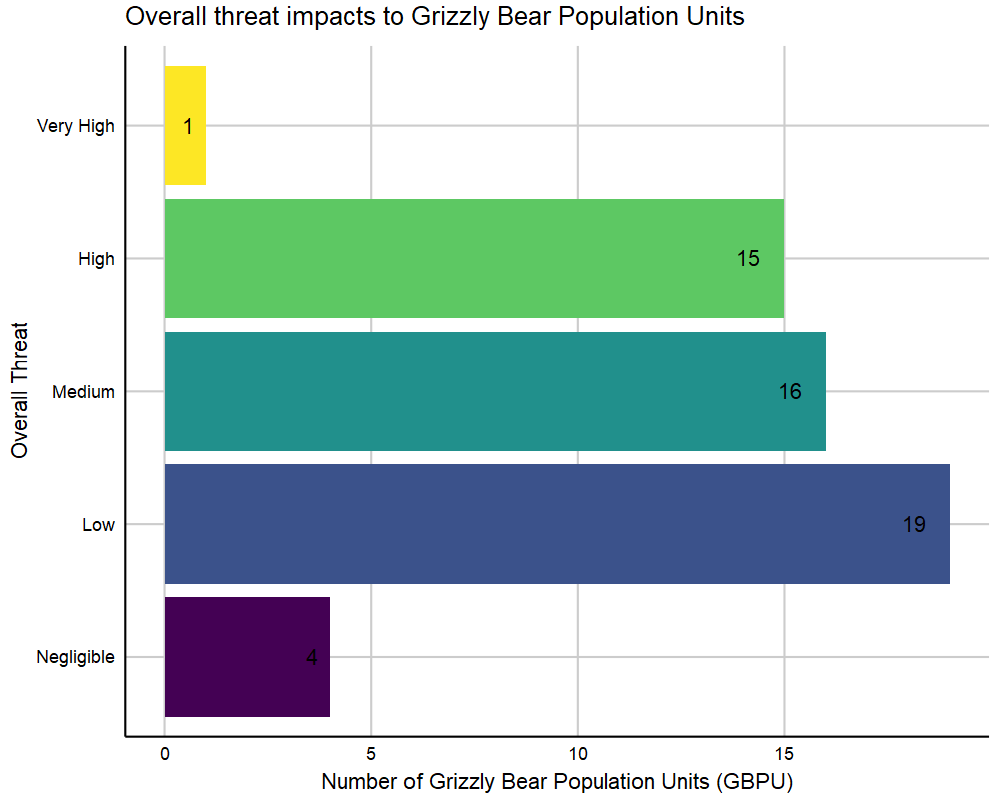Grizzly Bear Conservation Ranking in B.C.
- Grizzly bears are an important part of the British Columbia landscape.
- They are a symbol of ecological integrity that represents much of what British Columbians and visitors alike appreciate about B.C.’s natural beauty.
- B.C. is host to some of North America’s last remaining places where large predators and their prey play out their millennia-old roles. Grizzly bears are a key part of these systems.
- Grizzly bears are listed as a species of ‘Special Concern’ under federal legislation1 and ranked as S3? (Vulnerable Uncertain) provincially 2.
- Grizzly bears are divided into 55 Grizzly Bear Population Units (GBPU) in B.C. These units range in area from approximately 2,700 km2 to 50,000 km2. Very few of these units are isolated enough to be considered discrete biological populations, however they help managers to identify local conservation concerns, track grizzly bear population trends and apply specific management practices.
- GBPUs are rated from low to extreme conservation ranking. Rankings are determined using internationally recognized methods developed by NatureServe3 and the International Union for Conservation of Nature (IUCN). GBPU conservation rankings are based on; 1) population size and isolation, 2) population trend, and 3) level of threat to bears or bear habitat. The level of threat considers seven sub-categories; including Residential, Agriculture, Energy, Transportation, Biological Use, Human intrusion and Climate Change. See below for detailed methodology 4.
- Human development is the greatest threat to Grizzly bears in B.C. Development can impact bears directly by increasing the frequency of bear and human conflict, leading to higher mortality, and indirectly by reducing habitat availability due to human-caused disturbance and avoidance by bears. The expansion of human settlements and agriculture can lead to isolation of grizzly bear populations which reduces the movement of bears into the area to compensate for local mortalities.
Tip: Click on the interactive map below to explore conservation ranks, population density estimates and threats facing Grizzly bear population units (GBPU).
- Conservation Ranking: Of the 55 Grizzly Bear Population units (GBPU), conservation ranking was extreme for three GBPUs, high for 14 GBPUs and moderate for 14 GBPUs with the remainder of lower conservation rank.
- Population Density Estimates: Grizzly Bear population densities are estimated between 1 - 49 adults/1000 km2. North Selkirk GBPU had the highest population density.
- Overall Threats: Approximately half of all GBPUs (23 GBPUs) had an overall threat of Low or Negligible. Yahk GBPU, located in the Kooteney-Boundary, had the highest overall threat due to combined risks of Agriculture, Human Intrusion, Residential, Transportation and Biological Use.
Threats to Grizzly Bear Populations in B.C.

- Across all GBPUs, Human Intrusion was the most common threat, followed by Transportation (road and rail density), Energy production and Mining, Agriculture (livestock density), Residential (human density), Biological Use (mortality), and Climate-Change (salmon decline).

Methods
- Conservation ranks were calculated using Nature Serve's Element Rank Calculator in conjunction with Provincial bear biologists. This ensured rankings are consistent with international standards (B.C. Conservation Data Centre, NatureServe, IUCN).
- Each GBPU was assigned a rank based on population size and trend, genetic and demographic isolation, and overall threat to grizzly bears and bear habitat. GBPUs started with a score of 5 (no conservation concern) with points reduced for 1) declining population trend, 2) small and/or isolated population, and 3) increasing overall threat.
- Population trend was measured over 3 generations (~30 years). If the population decreased by more than 25% the overall score was reduced, leading to a lower conservation ranking.
- Population size and isolation are combined such that smaller isolated population’s rank scores could be reduced by as much as 4 points, whereas large well-connected populations are not downgraded.
- Threats were determined using categories identified by IUCN-CMP. Threats were quantified using published spatial data, including Statistics Canada, B.C.’s Baseline Thematic Mapping, Digital Road Atlas, Fish and Wildlife hunter and mortality data and Federal Department of Fisheries and Oceans’ Salmon escapement. The NatureServe calculator combined individual threats into an overall threat class.
- The full ranking report4 detailing ranking methodology and results can be viewed on the B.C. Grizzly Bear webpage.
- The R code for creating the charts and maps presented on this page is available on GitHub.

Photo credit: BC Parks
References and Other Useful Links
- 1Species at Risk Act (2002)
- 2B.C. Conservation Status Rank
- 3NatureServe. 2015. NatureServe Element Occurrence Viability Calculator Version 1. NatureServe, Arlington, VA
- 4Province of British Columbia. 2019. Ranking the Conservation of Grizzly Bear Population Units
- British Columbia's Bear Smart Program
- British Columbia Ministry of Environment. 2016. British Columbia guide to recovery planning for species and ecosystems at risk. B.C. Ministry of Environment, Victoria, B.C.
Data
*By accessing these datasets, you agree to the licence associated with each file, as indicated in parentheses below.
Download a printable version of this indicator (PDF, 0.8MB)
Updated November 2020
Suggested Citation: Environmental Reporting BC. 2020. Grizzly Bear Population Ranking in B.C. State of Environment Reporting, Ministry of Environment, British Columbia, Canada.


 Your
screen is too small to display the interactive map. Click to see the interactive visualization in
full-screen.
Your
screen is too small to display the interactive map. Click to see the interactive visualization in
full-screen.